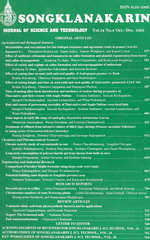ThaiScience
ThaiScience
SONGKLANAKARIN JOURNAL OF SCIENCE & TECHNOLOGY
Volume 43, No. 01, Month JANUARY, Year 2021, Pages 195 - 202
Distribution of aquatic plants in nong han wetland, thailand
Somsak Rayan, Saifon Kaewdonree, Amornrat Rangsiwiwat, Boontiwa Chartchumni
Abstract Download PDF
Aquatic plants are regarded as primary producers that play a significant role in the ecosystem. Thus, the distribution of aquatic plants has a substantial impact on aquatic organisms. The purpose of this research was to study the spatio-temporal variation of the distribution of aquatic plants in Nong Han wetland, Thailand. According to the results, there were 31 species and 22 families of aquatic plants in Nong Han wetlands with the mean biomass of 13,991.44 g m-2; where by Potamogeton malaianus Miq was the dominant species with highest biomass. In addition, the central wetland to the east had the highest amount biomass, and the period between February and April had the greatest influence on the biomass of aquatic plants. Moreover, the mean value of chlorophyll-a was found to be 0.021±0.014 mg l-1, indicating a high eutrophic level. Eichhornia crassipes and Salvinia cucullatas were invasive species with the tendency to cause damage to the water body in the future. Accordingly, to maintain ecological balance and sustainable output, stakeholders should implement preventive measures, eliminate invasive plants, and reduce the discharge of organic substances which are the source of plant nutrients into the water body.
Keywords
aquatic plants, biomass, distribution, Nong Han wetlandSONGKLANAKARIN JOURNAL OF SCIENCE & TECHNOLOGY
Published by : Prince of Songkla University
Contributions welcome at : http://rdo.psu.ac.th
